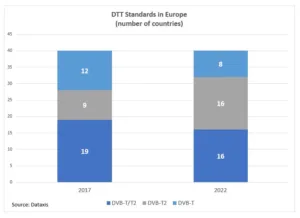Dataxis’ latest research sheds light on the importance that DVB-T2, the extension of the television standard DVB-T, will acquire in the next four years. This system was devised to enable more efficient signal transmission for broadcast digital television.
It became the widespread standard of all recent DTT deployments and is currently being rolled out to replace DVB-T in many parts of the world. Even though the freed-up spectrum can allow the broadcast of Ultra HD content or additional channels, the necessity of these improvements in some parts of Europe remains questionable.
In 2017, 12 countries still used hybrid networks (DVB-T and DVB-T2), with the two standards being used on different multiplexes. Dataxis forecasts that this number will decrease to eight in 2022, provided that national authorities do not put the switch-over on hold as has happened in Belgium and Sweden.
Consequently, Dataxis’ forecasts emphasise the growth in DVB-T2 implementation in Europe. In 2017, 30% of households received DTT using the DVB-T2 standard and this figure will grow to 72% by 2022.
This increase is primarily due to the switchovers planned in several European countries such as Italy and Spain, which are expected to reach 25.8 million—or 57%—of all DVB-T2 households.
The question remains as to whether the investments required by DVB-T2 will be worth it for the remaining countries, which managed to implement HDTV via DTT by conducting a shift from MPEG2 to MPEG4. Moreover, the growth will mainly be driven by free-to-air (FTA) reception, which will remain the primary way of receiving DTT for 91% of all digital households.
DVB-T2 will also prevail in Pay DTT since, in some countries, the switch-over will cause the disappearance of FTA DTT.
Nonetheless, this development raises questions on the equipment needs that countries will have to cope with in a few years if the infrastructure change doesn’t go along with a significant renewal of enabled devices.

